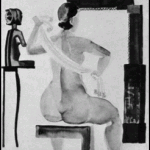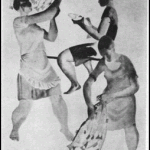Drawing is an essential component in any pictorial and plastic idiom.

Drawing can be an accurate gauge of professional artistic achievement at a given historical period. Not only in graphic works, but in sculptures and paintings, decorative objects and architectural constructions it defines the delineation of form, spatial arrangement of masses, architectonics and composition. An art requiring the simplest and easily obtainable materials — a pencil, a pen and a sheet of paper, it reveals with great emotional force and directness the artist’s individuality, his personal style and vision. Laconically and pungently drawing discloses all that is specific and characteristic in the contemporary artistic process, its ideological and aesthetic principles and quests.
Drawing belongs to the family of graphic arts. Its study as a category of art is far beyond the scope of one article. Indeed, only illustrative material needed for a comprehensive survey would take several albums. Each type of drawing taken separately — children’s, applied, technical, scientific or artistic — can well be the subject of research. Among the different varieties of artistic drawing we find a sketch and a study, a preliminary draught for a painting, a sculpture, an engraving or a monumental work, a magazine drawing, an illustration and, finally, a finished easel drawing — an independent form of artistic representation of reality.
Most of the works reproduced in the album are Soviet easel drawings- done between 1960 and 1975. They are grouped according to genres, materials and techniques. The authors thought it useful to include several drawings dating from earlier years, which would enable the reader to look at the art in retrospect. This, they hope, will give him an idea of its main trends and show what has been achieved in the recent years and what belongs to tradition.
In our days the easel drawing, like all Soviet visual arts, undergoes deep and varied changes. These changes are brought about by the development of moral and intellectual qualities specific to our society. They bear witness to the artists’ interest in the inner life of their contemporary, his sentiments and feelings.
Drawing can reflect the artist’s vision of life with greater immediacy that any other art. But directness and fidelity in conveying one’s impressions are not yet everything that is required of an artistic work. Making a drawing means also thinking with a pencil in hand, means analyzing and generalizing what one sees, means creating, along with sketches and draughts for future graphic compositions, paintings and sculptures, fully independent works, mature in their conception and form. All these requirements are met by the modern easel drawing. Remaining a highly personal and individualized genre, capable of a subtle penetration into the world of inmost feelings, drawing attempts psychological and social generalizations which are typical of the modern easel art as a whole. More than that, the easel drawing sometimes acts as a fermenting-agent, stirring up the turbulent artistic process and helping to shape the distinctive style of the time.
A contemplative and analytical approach, concentration on the most topical subjects sometimes suggests to the authors of drawings, who are not always graphic artists, new plastic conceptions and ideas.
The greater part of the contemporary drawings are drawings from life. Nevertheless, their most notable features are an ability to capture the essence of things, quests for the typical in ordinary facts and motifs, the desire to convey the poetry of the world around the man and the harmony of his relationship with life. In a drawing of this kind the principles of composition are definite and precise: to see what is being arranged, to see what is being selected, to see — and not just look and depict everything that comes within eyeshot. Such a selective approach to the subject-matter determines the forms and patterns of expression in the modern drawing.





























